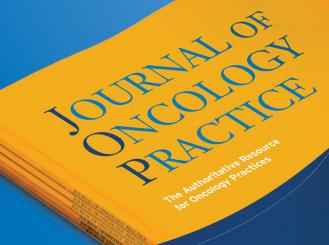Jul 20, 2015
A study out of the Smilow Cancer Hospital (SCH) in New Haven, Connecticut, assessed the outcomes of an intervention designed to address barriers clinicians face in documenting patients’ emotional distress. The study, “Incorporating Patient-Reported Outcomes to Improve Emotional Distress Screening and Assessment in an Ambulatory Oncology Clinic,” found that due to the intervention, rates of emotional distress screening jumped from 19.2% to 34% over six months. The study was published in the Journal of Oncology Practice (JOP) online, ahead of print, April 14.
According to the study’s first author, Anne C. Chiang, MD, PhD, the study “represents the nuts and bolts work that goes on in a clinic." In addition, it shows that the clinics in the study had the bandwidth to carry out emotional distress screening. “I was very excited to see that we were very much able to incorporate patient-reported outcomes into our workflow and to capture these reports in the electronic medical record.”
A QOPI report uncovers a need for greater screening
The catalyst for the intervention was a 2012 assessment through the Quality Oncology Practice Initiative (QOPI), ASCO’s physician-led quality reporting and improvement program. The report found that among patients seen at SCH Care Centers—which provide cancer services by Yale Cancer Center clinicians in ten local care centers—49% of patients had documented screening for emotional well-being, assessed by the second office visit. The finding that caught the researchers’ attention, however, was that in two out of the ten SCH Care Center sites, fewer than 12% of patients had received screening.
In 2012 the American College of Surgeons’ (ACS) Commission mandated that cancer centers would now have to screen patients for emotional distress in order to receive accreditation (In 2014, ASCO issued the guidelines, “Screening, Assessment, and Care of Anxiety and Depressive Symptoms in Adults with Cancer”).
Based on the QOPI results, the multidisciplinary research team turned to the ASCO Quality Training Program for guidance in developing an intervention to increase screening rates. Using “process mapping,” the research team identified the top four barriers to screening: Not enough time with patients, lack of social work resources; lack of privacy and space; and patient discomfort in discussing emotional distress.
Based on these findings the researchers developed an intervention in which registered nurses gave all patients the National Comprehensive Cancer Network (NCCN) Emotional Distress Thermometer (EDT) paper tool. The tool indicates distress on a scale of 0 to 1, specifies specific causes of distress, and asks whether patients are willing to talk to a social worker. According to Dr. Chiang, this intervention was chosen because “it hit the sweet spot between a process that is high-impact and one that is relatively easy to implement.”
As part of the intervention, the researchers also ensured that social workers were available to all patients.
Intervention yields higher rates of screening and provides insights into the causes of patient distress
During the intervention’s one-month pilot period in February 2014, registered nurses’ documentation of emotional distress screening rose from 29% to 41%. This increase continued over the next six months; From February to July 2014, nurses collected 864 EDTs from 1,344 patients in the two SCH ambulatory clinics; a review of 445 medical records showed that the percentage of patients who showed documentation of emotional distress screening in electronic medical records increased from 19.2% to 34% during this time.
Patient responses on the EDT also revealed their level of emotional distress: 62% of patients indicated mild distress, 18% indicated moderate distress, and 11% indicated severe distress. When drilling down to the specific cause of distress, the data revealed that for patients with moderate and severe distress the top problems were worry, fatigue, pain, and nervousness. Depression and sadness were particularly noted in patients reporting severe distress. Eleven percent of patients were referred to social workers on site.
Looking ahead
Dr. Chiang said the study’s results have served as a springboard for future studies on causes of distress, such as pain and fatigue, among patients with cancer. In addition, the study’s findings have already translated into real-world results: Currently, emotional distress screening protocols are being introduced into all SCH clinics.
“I think this study is a really great example of how we can take a best practice from the community that’s really patient-centered and implement that practice across the whole system,” said Dr. Chiang.
Anne C. Chiang, MD, PhD, is an Assistant Professor of Medicine (Medical Oncology) at Yale School of Medicine and the Chief Network Officer and Deputy Chief Medical Officer at the Smilow Cancer Hospital. An ASCO member since 2004, Dr. Chiang is currently Chair of the Quality of Care Committee.
Abstract of the original JOP article.
PDF of the original JOP article.
Chiang AC, Amport SB, Corjulo D, et al. Incorporating patient-reported outcomes to improve emotional distress screening and assessment in an ambulatory oncology clinic. J Oncol Pract. Epub 2015 April 14.
The Exclusive Coverage series on ASCO.org highlights selected research from JCO and JOP with additional perspective provided by the lead or corresponding author.
@ 2014 American Society of Clinical Oncology


